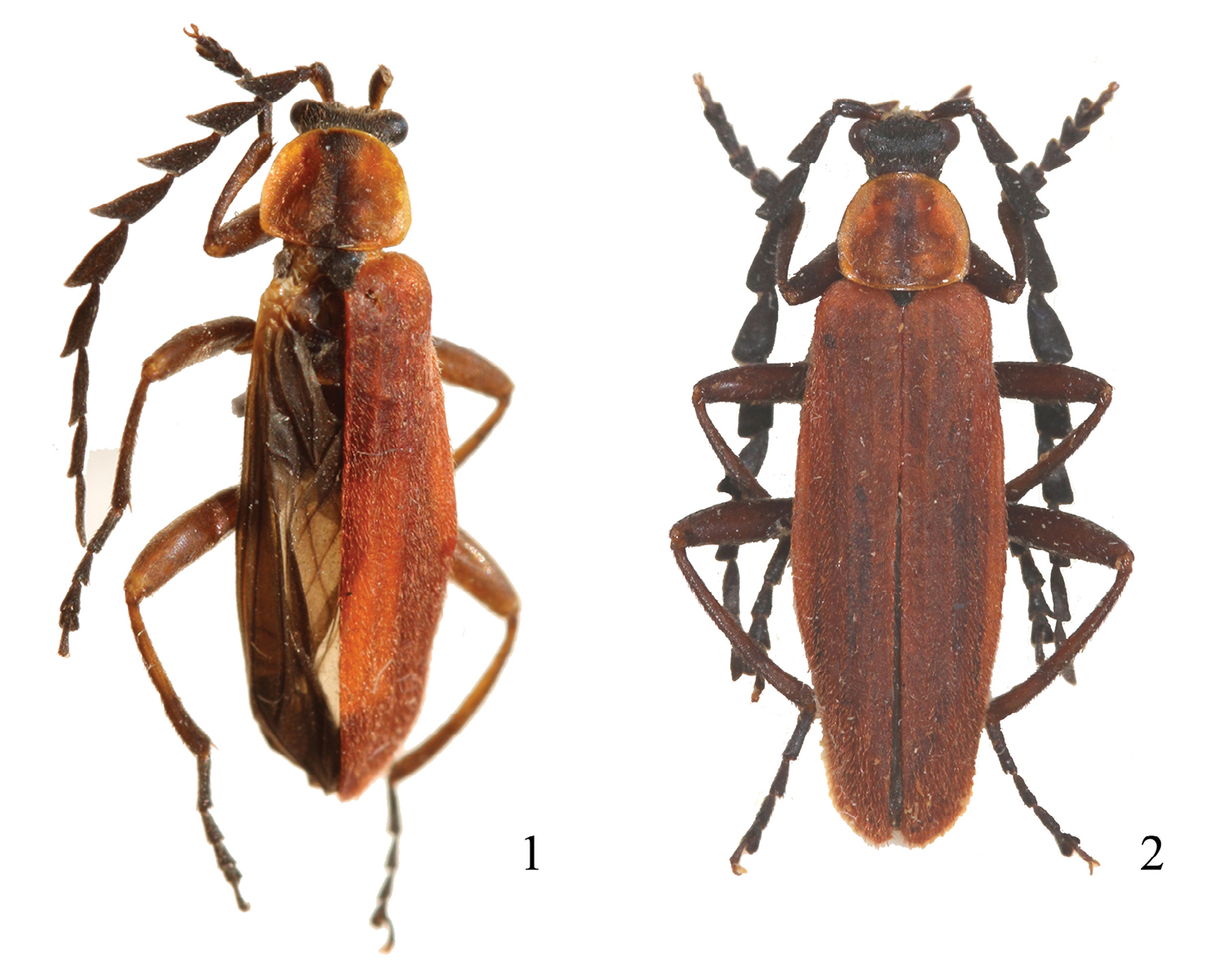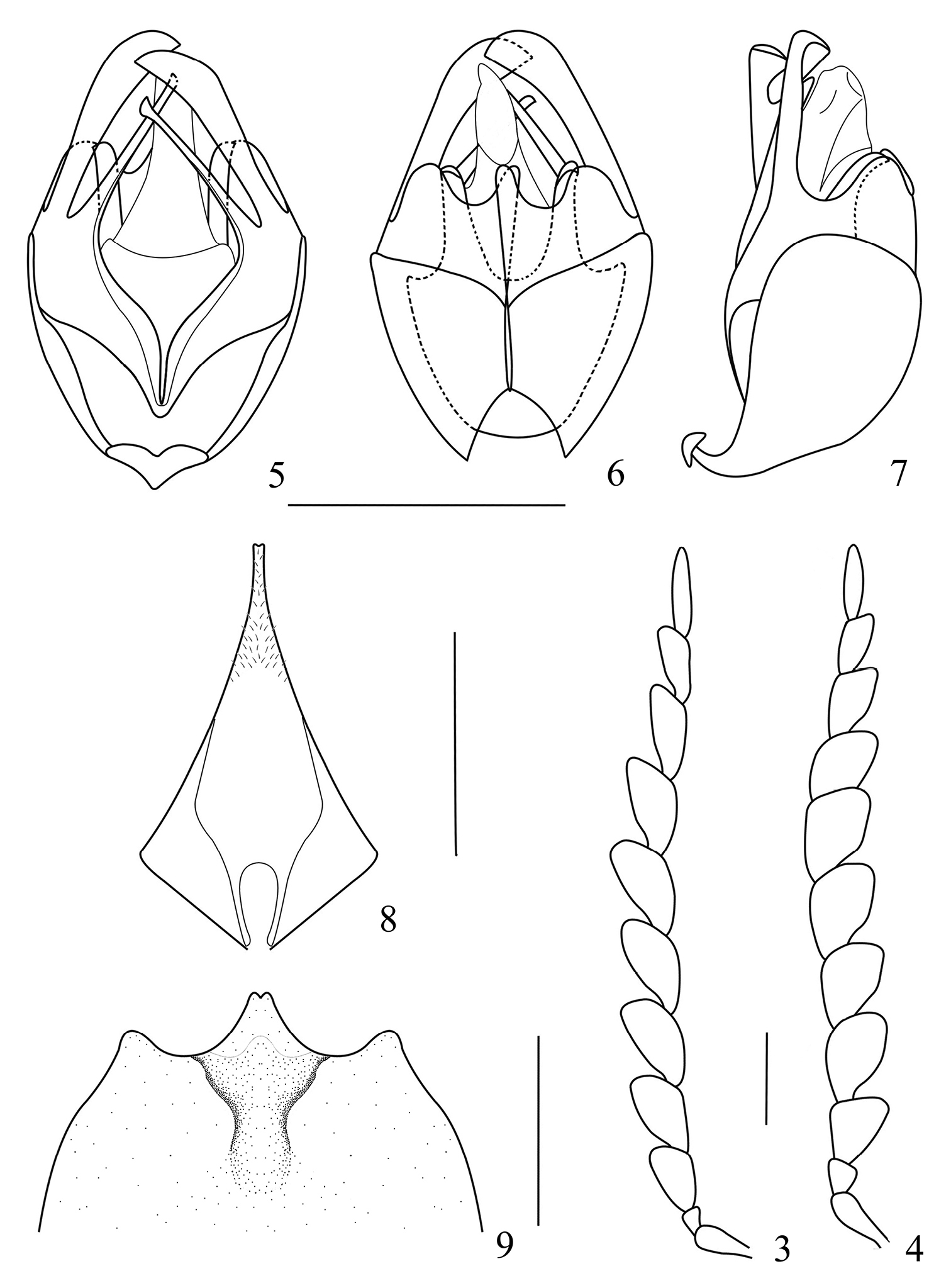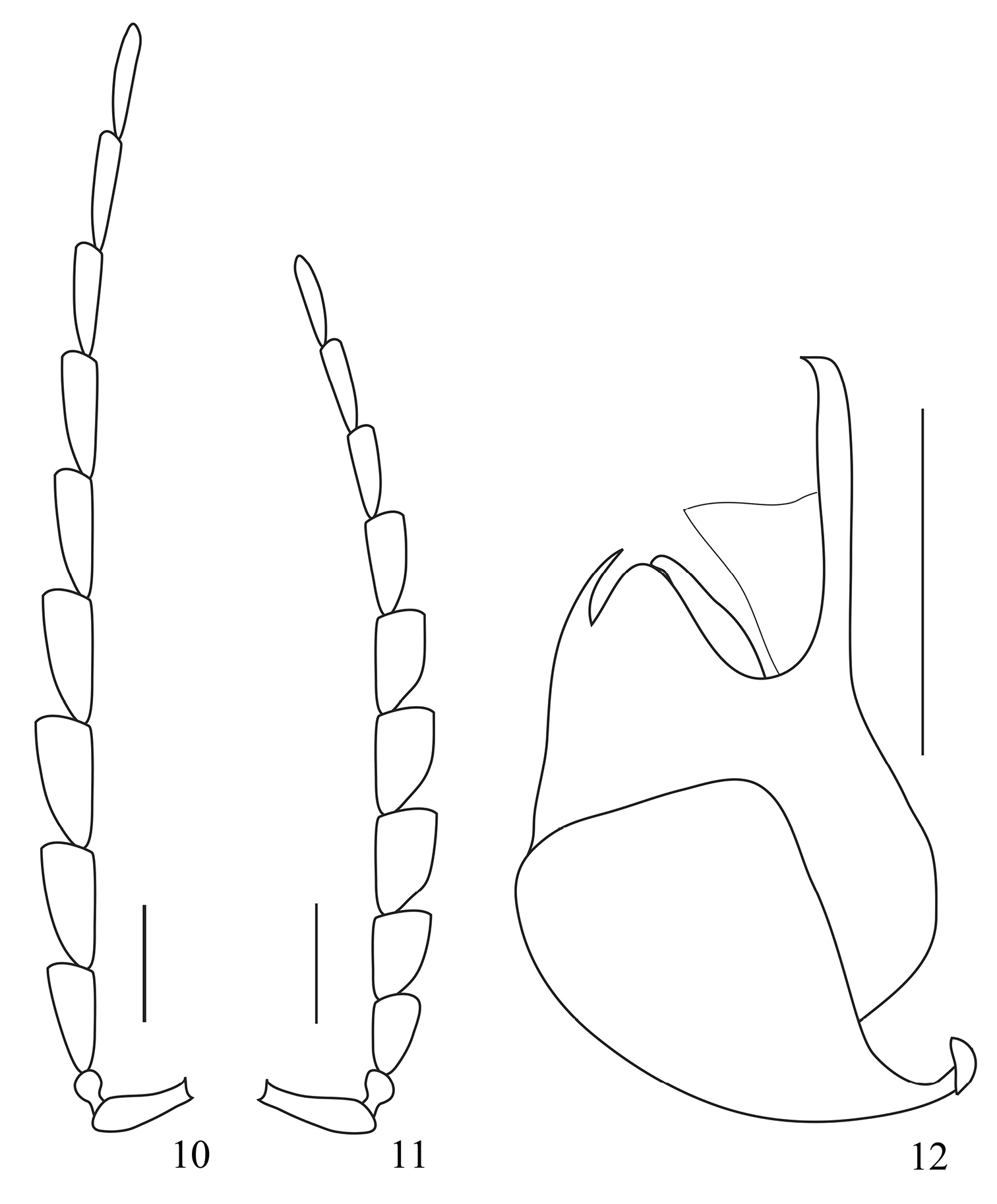






(C) 2011 Yuxia Yang. This is an open access article distributed under the terms of the Creative Commons Attribution License, which permits unrestricted use, distribution, and reproduction in any medium, provided the original author and source are credited.
For reference, use of the paginated PDF or printed version of this article is recommended.
Two remarkable new cantharid species were described, Prothemus laticornis sp. n. (CHINA: Yunnan) and Prothemus lycoceroides sp. n. (THAILAND: Chiang Dao), and provided with illustrations of aedeagi, ultimate abdominal sternites and antennae of both sexes. Their systematic status was discussed, because they differed from all other species of Prothemus in the dilated and/or serrate antennae and elytra with distinct longitudinal costae and longer pubescence.
Coleoptera, Cantharidae, Prothemus, new species, China, Thailand
The genus Prothemus was proposed by Champion in 1926, with Prothemus neglectus originally designated as the type species. Most of the taxonomic work on this genus was contributed by
Recently, we received two interesting cantharid species from China and Thailand respectively. By the external characters, it was not easy to determine whether they belonged to Prothemus or Lycocerus Gorham, 1889, or a new genus, because their tarsal claws (pro- and meso-outer tarsal claws each roundly appendiculate in male, while simple in female) and rounded pronotum matched the diagnosis of Prothemus, while their serrate antennae and pubescent elytra, which characters were common in some Lycocerus species, have not been reported in Prothemus. After studying the aedeagi of the two species, we discovered that they were of the typical Prothemus type. Based on all the above characters, also taking into account that the same variation in the antennae and pubescence occurred in other genera of Cantharinae, such as Fissocantharis Pic, 1921, Lycocerus Gorham, 1889 and Habronychus Wittmer, 1981, we considered that these species to be the members of Prothemus, and described them here under the names of Prothemus laticornis sp. n. and Prothemus lycoceroides sp. n..
Material and methodsThe type specimens are deposited in the Institute of Zoology, Chinese Academy of Sciences, Beijing, China (IZAS), Hebei University Museum, Baoding, China (HBUM) and Dr. SV Kazantsev’s private collection at Insect Centre, Moscow, Russia (ICCM).
The aedeagi were detached from the body under a stereoscopic microscope and kept in 10% KOH solution for several minutes, then cleared in 75% alcohol and observed under a compound light microscope. Line figures were drawn with the aid of a camera lucida mounted on a Nikon SMZ 800 stereomicroscope. The scanning electronic micrographs were edited in CORELDRAW 12 and ADOBE PHOTOSHOP 8.0.1. The habitus photos were taken by Canon 450D digital camera with a Canon EF 100mm f/2.8 USM Macro Lens. The body length was measured from the anterior margin of clypeus to apex of elytron, and width was at the point of maximum width of the conjoint elytra. Absolute measurements were used in millimetres (mm).
Taxonomyurn:lsid:zoobank.org:act:445C8C99-D76C-4A9F-8CBA-07B2143F15D8
http://species-id.net/wiki/Prothemus_laticornis
Holotype male, CHINA: Yunnan, W. Cangshan, 2100m, 3.vi.2008 (IZAS). Paratypes: one male, Yunnan, Cangshan, 21.v.2009, leg. Shoubin Li (HBUM); one female, Yunnan, Yangbi, Xueshanhe, 2000–2800m, 6–8.vi.2004, leg. Song Wang (IZAS); one female, same data as the latter, leg. Xueyan Guo (IZAS); one female, Yunnan, E. slope Cangshan, Mojian, 2.vi.2009, leg. Jianhui Zeng (HBUM)[above transferred from Chinese labels]; two females, Yunnan, Gaoligong Mts., 1500–2500m, 25.22°N, 98.49°E, 17–24.v.1995, leg. V. Kubáň (ICCM).
China (Yunnan).
This new species can be easily distinguished from all others of Prothemus by the serrate antennae and elytra with distinct longitudinal costae and longer pubescence.
Male (
Male habitus, dorsal view 1 Prothemus laticornis sp. n. 2 Prothemus lycoceroides sp. n.
Head surface densely and finely punctate,
slightly depressed on vertex; eye slightly protruding, breadth across
eyes narrower than maximum width of pronotum; ultimate maxillary
palpomere elongate, securiform, widest near base, acute at apex;
antenna (
Pronotum slightly wider than long, widest near base, anterior and lateral margins rounded, posterior margins nearly straight, all angles rounded, disc distinctly convex, with an obscure median longitudinal groove.
Elytra about 5 times longer than pronotum and 5 times longer than wide at humeri, humeral width distinctly wider than that of posterior margin of pronotum, outer margins distinctly diverging posteriorly and slightly converging at apical one-third, disc surface densely and very finely punctuated, with 3 distinct longitudinal costae.
Abdominal sternite IX (
Aedeagus (
Female. Body larger and wider, eye less protruding, antenna (
Variation in type series. Legs sometimes mostly brown, pronotum sometimes entirely reddish brown, or with two black markings near middle of anterior and posterior margins respectively. Body length 9.0–13.0 mm, width 3.0–5.0 mm.
Prothemus laticornis sp. n. 3 male left antenna, dorsal view 4 female left antenna, dorsal view 5–7 aedeagus (5 ventral view 6 dorsal view 7 lateral view) 8 male abdominal sternite IX, ventral view 9 female abdominal sternite VIII, ventral view. Scale bars: 1 mm.
This new specific name is derived from Latin words latus (wide) and cornu (antenna), referring to its dilated antennae.
The holotype was damaged, its left elytron and right antennomeres VIII-XI were missing. Paratypes: the male with left antennomeres III–XI and right IX–XI and left pro-leg, one female with left antennomeres III–XI and another female with right antennomeres III–XI were missing.
urn:lsid:zoobank.org:act:3E254644-AAE8-473B-AB6A-FF3163B4A4EF
http://species-id.net/wiki/Prothemus_lycoceroides
Holotype male, THAILAND, Chiang Dao, 1000m, 19°25'N, 98°52'E, 17–24.v.1991, leg. V. Kubáň (ICCM). Paratypes, two males and one female, same data as holotype (ICCM).
Thailand (Chiang Dao).
Prothemus lycoceroides sp. n. is fairly similar to Prothemus laticornis sp. n., but distinguishable by the narrower antennae, less prominent longitudinal elytral costae and less curved apices of parameres of the aedeagus.
Male (
Head surface dorsally densely and finely
punctate, slightly depressed between eyes; ultimate maxillary palpomere
elongate, securiform, widest near base, acute at apex; antenna
extending to apical one-fourth of elytron, antennomere II as long as
wide at apex, III–VIII flattened and serrate, at least 2.0 times as
long as wide at apices, IX–XI slightly flattened and subparallel-sided (
Pronotum slightly wider than long, widest near base, all margins and angles rounded, disc distinctly convex, with an obscure median groove.
Elytra long, about 4.75 times longer than pronotum and 3.2 times longer than wide at humeri, humeral width distinctly wider than that of posterior margin of pronotum, almost parallel-sided, disc surface densely and finely punctate, with 2 distinct longitudinal costae.
Aedeagus (
Female. Similar to male, but larger and wider, eye smaller, antenna (
Body length 13.2–13.8 mm, width 3.0–3.3 mm.
Prothemus lycoceroides sp. n. 10 male right antenna, dorsal view 11 female left antenna, dorsal view 12 aedeagus (lateral view). Scale bars: 1 mm.
The name of the new species is modified from Lycocerus, alluding to its similarity to the members of some Lycocerus species.
| 1 | Antennae dilated and or serrate; elytra covered with distinct longitudinal costae and longer pubescence | 2 |
| – | Antennae filiform; elytra never like above | all other species |
| 2 | Antennae wider, male antennomeres III–VIII no more than 1.5 times as long as wide at apices, IX–X distinctly widened | Prothemus laticornis sp. n. |
| – | Antennae narrower, male antennomeres III–VIII at least 2.0 times as long as wide at apices, IX–X slightly widened | Prothemus lycoceroides sp. n. |
We were greatly surprised to see these strange species at first. Most of their morphological characters showed that they undoubtedly had to be placed in the subfamily Cantharinae. However, judging from the appearance, it was difficult for us to refer them to any genus. Their tarsal claws and pronotum matched the diagnosis of Prothemus very well, but they had dilated and/or serrate antennae and elytra with distinct longitudinal costae and slightly longer reddish brown pubescence, which were hitherto unknown in Prothemus, although common in some Lycocerus species. Dissection of their male copulatory organs showed they had the typical aedeagi of Prothemus. Based on external characters and male genital structures, we supposed that these species should be attributed to Prothemus, and their character states of elytra and antennae were considered to be apomorphic within the genus Prothemus. In the subfamily Cantharinae, the same variations in antennae and elytra also occurred in the genera Fissocantharis, Habronychus and Lycocerus. Hypothetically they mimic one another and/or some other beetle groups, such as Lycidae, in order to benefit from having similar appearance, for example, to protect themselves better or find more effective ways of attacking prey.
This study provided further proof that appearance of soldier-beetles within a single genus, at least in the subfamily Cantharinae, can vary significantly, while the aedeagal structures appear to be more conservative, apparently because they are subject to the selection pressure of the environment to a lesser extent than most external characters.
We were grateful to Dr. Zizhong Yang (Dali University, China) to provide us some studied specimens. This study was supported by the National Natural Science Foundation of China (No. 31010103913) and Science Foundation of Hebei University (No. 2010-203).


